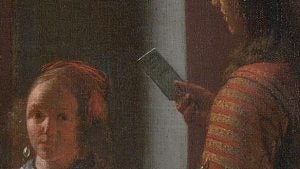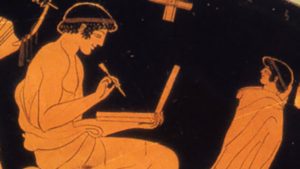Ye Olde iPhone spotted in 346-year-old painting by Apple CEO Tim Cook

Apple launched the iPhone in 2007, but it was actually invented in 1670. Maybe.
Tim Cook, the CEO of Apple, says he saw an iPhone in a 346-year-old painting, contradicting everything we thought we knew about the history of the smartphone.
Cook’s comments came during an interview at Startup Fest Europe in Amsterdam. The CEO was describing a visit to the Rijksmuseum the night before, where he was accompanied by Neelie Kroes, the European Commission for Digital Agenda. During the interview, Kroes asked Tim where the iPhone was actually invented, to which Tim Cook replied:
“You know, I thought I knew until last night. Last night, Neelie took me over to look at some Rembrandt, and in one of the paintings I was so shocked. There was an iPhone in one of the paintings.”
“It’s tough to see but I swear it’s there,” he joked. “I always thought I knew when the iPhone was invented, but now I’m not so sure anymore.”
 Could this be the first ever iPhone?
Could this be the first ever iPhone?
It turns out that the painting wasn’t actually a Rembrandt, however. In fact, Pieter de Hooch painted the piece, aptly titled ‘Man Hands a Letter to a Woman in a Hall’, in 1670. The letter does look a bit like an iPhone in fairness.
But we’ve done Tim Cook one better. It turns out that the iPad may have been invented long before the 17th Century iPhone. Check out Douris, an Ancient Greek, using an iPad Pro with a Smart Keyboard and Apple Pencil, circa 500BC:
 Ancient Greece was years ahead of Cupertino
Ancient Greece was years ahead of Cupertino
Impressive stuff.
Best Smartphone 2016: What’s the #1 phone right now?
Can you find any other examples of technology being discovered way before we thought it was? Let us know in the comments.


